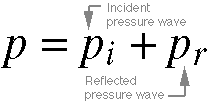Chapter 5: Generation and Propogation
of Sound

Equation 5.1. This equation determines the relative
amplitude, in decibels, that a given sound A has compared
to a reference sound A0. We use the reference
sound since decibels are only a relative measure of 'loudness',
and not an absolute measure.

Equation 5.2. The speed of sound, c, varies
according to the medium the sound is traveling through. Specifically,
from Equation 4.1, we
know that the frequency of a mass-spring oscillator is proportion
to the square root of the ratio of stiffness to mass. If
the medium is stiffer when compressed, the sound waves will
travel (propagate) faster. If the medium is more stretchy
and elastic, waves will travel slower through it. The mass
we are concerned with is not the total mass of the medium,
but its density, or mass per unit volume. The greater the density
of the surrounding medium (usually air, for our purposes),
the slower sound will propogate through it. The elastic
modulus refers to stiffness, and the inertial modulus refers
to density.

Equation 5.3. This is a more specific version of
Equation 5.2. P, the atmospheric pressure of the surrounding
air, is substituted in for the elastic modulus, and the air
density is substituted for the inertial modulus.

Equation 5.4. Equation
2.10 tells us that for a gas, pressure and volume are
inversely proportional. Also, pressure is directly proportional
to temperature. Plugging those concepts into Equation 5.3
gives us this equation. Temperature is relevant here, because
the vocal tract is generally warmer than the average outside
temperature. The speed of sound is about 350 m/s in the
vocal tract, as opposed to 343 m/s under average atmospheric
conditions.

Equation 5.5.

Equation 5.6.

Equation 5.7.

Equation 5.8.

Equation 5.9.

Equation 5.10.

Equation 5.11.
The above seven equations all deal with the motion of a wave through space
and time, so we will deal with them together. 5.5 simply states that an object
traveling at a velocity c will travel a distance x during a
period of time t. Sound waves aren't objects, of course, but we can
treat them as such for our purposes. 5.6 defines the pressure p in
terms of an arbitrary function f. This function could be a sine wave,
a bell curve, or whatever shape that describes the disturbance in air pressure
that the sound wave causes at a given moment. The variable x' is the
distance from the peak of the wave. In 5.7, we calculate the distance from
the origin of the wave to the peak of the wave. Now if x = ct + x',
then x' = x - ct; we can see this from simple subtraction. And since
5.6 tells us that p = f(x'), we can simply substitute in x - ct in
place of x'. This is done in Equation 5.8. The last three equations,
(5.9 thru 5.11), are restatements of 5.8, given here and in the book to show
that reversal of the sign or the order of the variables does not alter the
fundamental properties of the wave as it moves through a medium.

Equation 5.12: Sinusoidal Waves. The formula for
determining the pressure variation, p, of a sinusoid
is given here. The phase angle Q0 determines the time at which the sinusoid
reaches its peak. The peak of our wave travels at a velocity c,
and so we know that for our wave to travel a given distance x,
it will take an amount of time x/c. This leads to
the next equation...

Equation 5.13. This is the phase angle. Substituting
this into 5.12 for the Q0 term
gives us the next equation.

Equation 5.14. This describes a sinusoidal pressure
wave moving to the right, also known as a forward wave. This
is just a fleshed out version of Equation 5.8, with the generic
function f replaced with a real function -- that of
a sinusoid. If the sinusoid were traveling backwards, there
would be a + sign in the parentheses instead.

Equation 5.15: Wavelength. Wavelength is the distance
between successive iterations of a wave. For a simple sinusoid,
it's the distance between each peak in pressure; each 'hump'
in the wave. Wavelength is determined both by the frequency
of the source and by the medium. High-frequency sources,
for instance, produce many pressure peaks per second, and
since the velocity of those peaks (the speed of sound) is
fixed and determined by the medium, the peaks will be relatively
close together. Low-frequency sources will generate peaks
which are further apart. Our equation states that wavelength
is the speed of sound divided by frequency. The next two
equations are derived from 5.14 and 5.15 by substitution:

Equation 5.16.

Equation 5.17.

Equation 5.18: Wave Impedance. Wave impendance is
the ratio of pressure to the speed of the air particles being
pushed by that pressure. Wave impedance is also related to
the speed of sound, as we see in the next equation:

Equation 5.19. Here, we see that wave impedance
is equal to r, which is the air density, multiplied by c,
the speed of sound.

Equation 5.20. Our last three equations for this
section govern reflections of sound. The total pressure p in
5.20 is the sum of pi, the incident pressure
(the pressure which is hitting the surface that the wave
is reflecting from), and pr, which is the
pressure that is reflected back from the surface.

Equation 5.21. In real life, the surfaces which
sound reflects from are not perfectly stiff; they do not
reflect back all of the energy directed at them. The reflection
coefficient tells us how much energy survived the collision
and got reflected. It is derived simply by dividing the reflected
energy by the original energy that the wave possessed.

Equation 5.22. Here, Equation 5.21 is re-stated
in terms of wave impedances, as defined above in 5.18 and
5.19.
Chapter
4 Equations Equations
Homepage Chapter
6 Equations
|



